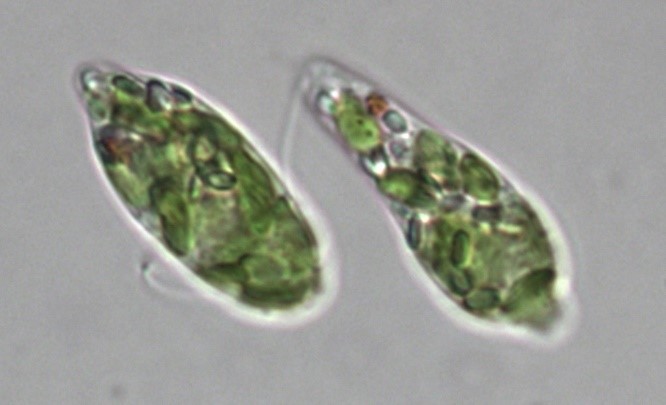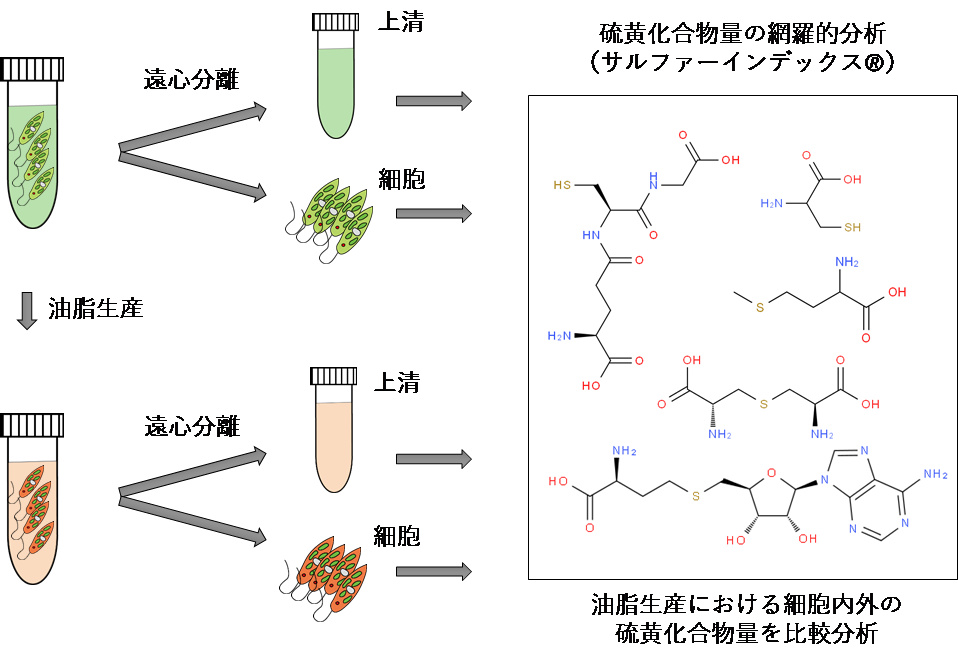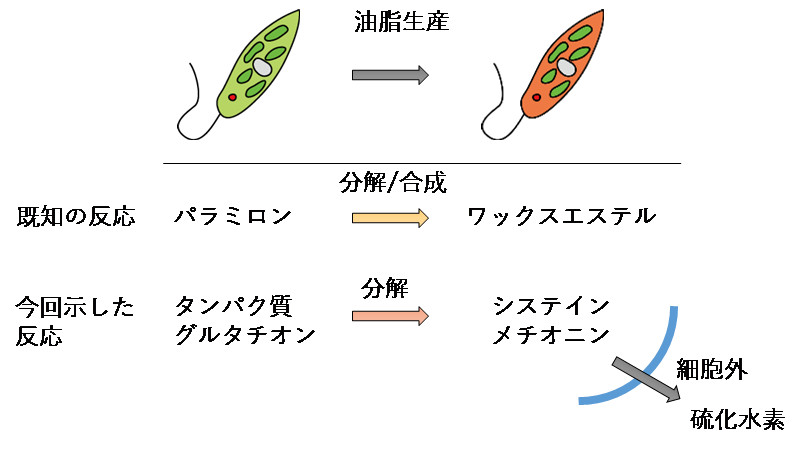ニュースリリース
※ ニュースリリースは発表当時の内容を掲載しており、最新の情報とは異なる場合がありますためご注意ください。
ミドリムシが油を生産する際の硫黄に関する副次的反応を解明
バイオ燃料生産効率化に貢献する成果
株式会社ユーグレナ
国立研究開発法人理化学研究所
国立大学法人筑波大学
ポイント
○ サルファーインデックスを利用してミドリムシの硫黄化合物の代謝を観測した。
○ ミドリムシが油を生産する際に硫化水素が発生することを確認し、その原因を解明した。
○ ミドリムシの産生する油脂を利用したバイオ燃料の生産効率化に貢献することが期待される。
| 株式会社ユーグレナ、理化学研究所、および筑波大学の研究チームは、ミドリムシ(学名:微細藻類ユーグレナ)の油脂生産時における硫黄化合物の代謝変化の実態を明らかにしました。 ミドリムシは、食品やバイオ燃料への応用が進められています。特に、バイオ燃料生産に応用する際の課題として、生産性を上げることと同時に、油脂を生産するプロセスにおける硫黄化合物系の臭いの発生が課題として挙げられています。 本研究チームは、サンプル中の硫黄化合物を網羅的に解析することができる技術であるサルファーインデックス(※1)を活用することで、発生する臭いの主成分が硫化水素(※2)であることを突き止め、さらにその発生原因がミドリムシ細胞内のタンパク質、およびグルタチオン(※3)の分解に由来することを明らかにしました。 この情報をもとに、ミドリムシの油脂生産性をあげることや臭いの発生を抑制する技術の開発が可能になると考えられ、高効率バイオ燃料の研究などを加速させることに役立つことが期待されます。 本研究成果は、2019年1月29日午前10時(英国時間)にネイチャー・パブリッシング・グループ(NPG)の電子ジャーナル「Scientific Reports」(www.nature.com/articles/s41598-018-36600-z)で公開されました。 |
本成果は、以下のチームの連携によって得られました。
| 株式会社ユーグレナ 執行役員研究開発担当 先端技術研究部長研究代表者:鈴木健吾(チームリーダー) |
理化学研究所 環境資源科学研究センター バイオ生産情報研究チーム チームリーダー研究代表者:持田恵一 |
筑波大学 生命環境系 准教授 研究代表者:大津厳生 |
 |
 |
 |
株式会社ユーグレナと理化学研究所による共同研究は、理化学研究所が推進する産業界のニーズを重要視した連携活動「バトンゾーン研究推進プログラム」の一環として、共同研究開発チーム(微細藻類生産制御技術研究チーム)を設置することで連携を促進しています。
<理化学研究所 バトンゾーン研究推進プログラム>
■研究開発チーム:微細藻類生産制御技術研究チーム
■研究期間:2018年4月~2023年3月
■チ ー ム リ ー ダ ー:鈴木健吾(株式会社ユーグレナ)
■プログラムについて:http://www.riken.jp/research/labs/bzp/
また、株式会社ユーグレナと筑波大学は、硫黄化合物を用いた疾患の新しい指標や診断方法の構築を目指す「セルフメディケーション推進特別研究事業」を開始しており、硫黄化合物の高度な解析手法の開発を基としたセルフメディケーション関連事業への実用化を推進しています。
<セルフメディケーション推進特別研究事業>
■研究開発体制:株式会社ユーグレナ、筑波大学
■研究期間:2018年7月~2021年3月
■事業について:https://www.tsukuba.ac.jp/wp-content/uploads/108629euglena.pdf
<発表内容>
1)研究の背景と経緯
ミドリムシ(ユーグレナ)は微細藻類の一種で、淡水の湖沼、田んぼなどに生息する理科実験における観察でもおなじみの単細胞生物です。50種類以上が知られるミドリムシのうち、ユーグレナグラシリス(Euglena gracilis, 図1)は50年以上も前からモデル生物(※4)として使われてきましたが、その豊富な栄養素、および細胞内に蓄積するβ-グルカンであるパラミロン(※5)の機能性から産業利用も検討され、2005年の大量生産技術の確立を機に株式会社ユーグレナにより健康食品の原料として供給・利用されてきました。
ミドリムシは豊富な栄養素を含むことと同時に、特定条件下で油脂を高い割合で蓄積することが知られており、その仕組みも研究対象とされてきました。それらの研究の成果により、周囲に酸素がない条件において、細胞内に蓄積したパラミロンを分解してエネルギーを獲得し、その反応における不要なものをワックスエステル(※6)という油脂の形で蓄積していることが明らかになっています。この現象はミドリムシ独特の発酵として、ワックスエステル発酵(※7)と名付けられています。ミドリムシのワックスエステルはバイオ燃料の原料として適しているとされることから、バイオ燃料生産にも利用が検討され技術開発が進んでいます。
パラミロンからエネルギーを取り出し、不要物を油脂として蓄積するという、これまでに知られている反応は炭素に注目した細胞内の反応の流れでした。一方で、油脂が蓄積する際に、同時に硫黄化合物の臭いがミドリムシから発生することが経験的に知られていましたが、その現象について深く追究されたことはありませんでした。本研究では、サルファーインデックスを利用することにより、この臭い発生の機構について明らかにすることを試みています。これにより、ワックスエステル発酵についてさらに深く知り、バイオ燃料の生産性を上げる技術開発につなげることを目指しています。
2)研究の内容
株式会社ユーグレナ、理化学研究所、筑波大学から構成された研究チームは、ミドリムシに油脂を作らせる処理を行い、そのサンプルをサルファーインデックスにより分析することで、ワックスエステル発酵の裏で起こっている硫黄化合物に関する副次的反応を明らかにしました。
サルファーインデックスはサンプルの中の硫黄化合物についてメタボローム解析(※8)を行い、各硫黄化合物の量を網羅的に定量することができる技術です。油脂を作らせる処理を行った後に、ミドリムシ、および培養液上清を別々に回収し、それぞれに含まれる硫黄化合物を測定しています(図2)。その結果、油脂を作らせたミドリムシの培養液上清において、硫化水素が含まれていることが確認され、これがワックスエステル発酵における臭い発生の原因であることがわかりました。さらに、細胞内に含まれる硫黄化合物量の変化を調べることで、油脂の生産に対応して、細胞内のシステインやメチオニンなどの含硫アミノ酸(※9)が増えていることが明らかとなり、同時にグルタチオンやタンパク質などの硫黄を含む化合物が減少していることがわかりました。これらのことから、グルタチオンやタンパク質が分解されて、システインやメチオニンなどの含硫アミノ酸が増えるという変化が細胞内で起こり、この含硫アミノ酸をエネルギー獲得のために分解した際に硫化水素が発生するという仕組みが新たに示唆されました(図3)。
さらに、ミドリムシによる油脂産生の際に、グルタチオンの分解を促進させる分子的原因を、バイオインフォマティクスにより解析しました。その結果、γ-グルタミルトランスペプチダーゼというグルタチオンの分解に寄与する酵素の量が変わらないのに対し、酵母などで発見された別の経路のグルタチオン分解酵素Dug1p、Dug2p、Dug3pに相当する酵素の量が増えていることが明らかとなりました。これにより、ミドリムシが油脂生産する際にDug1p、Dug2p、Dug3pからなる分解経路の強化によりグルタチオンの分解が促進していることが示唆され、硫化水素を発生させる分子的原因の一端が明らかとなりました。
3)今後の展開
今回、ミドリムシのワックスエステル発酵にともなって起こる、硫黄化合物に関係する副次的反応を明らかにしました。これを知ることにより、油脂生産における臭いの発生を抑制する技術の開発が可能となり、大規模にバイオ燃料を生産する際の環境への臭い放出を予防するとともに、残渣に含まれるタンパク質を増やし、飼料などへの利用価値を高めることに役立ちます。さらに、ワックスエステル発酵において油脂の生産性を上げるための方策を検討することが可能となり、高効率バイオ燃料の研究を加速させることに役立つことが期待されます。
本発表における研究は、株式会社ユーグレナ、理化学研究所、および筑波大学の協力により実施されました。株式会社ユーグレナにおいて調製されたサンプルを、筑波大学にて解析することにより得たデータにより現象の全体像が明らかとなり、理化学研究所環境資源科学研究センターにおけるバイオインフォマティクスにより、さらに現象への関与が示唆される酵素を提示しました。
株式会社ユーグレナと筑波大学における「セルフメディケーション推進特別研究事業」により、サルファーインデックスを活用促進することを目的として、本発表における研究を含め、様々な研究を企画実行しています。また、理化学研究所における「バトンゾーン研究推進プログラム」における合同チームの設立により、株式会社ユーグレナと理化学研究所の連携を加速しています。
<参考図>

図1. ユーグレナグラシリスの写真

図2. 硫黄化合物を網羅的に調べるためのサンプル準備と比較解析の概要
 図3. 今回の研究で発見された現象
図3. 今回の研究で発見された現象
油脂生産においてこれまで見逃されていた副次的反応の発見
<用語解説>
※1 サルファーインデックス
LC-MS/MS分析を基として、サンプル中の硫黄化合物量を網羅的に分析するサービス。http://www.euglena.jp/sulfurindex/
(大津厳生・大城聡 「揮発性低分子硫黄化 合物の定量方法、硫黄化合物含有物質の評価方法」 日本国特許 第6426329号 / WO/2018/201879 /
PCT/JP2018/018154 / 特願2017-094037)
※2 硫化水素
硫黄と水素からなる化合物であり、化学式はH2S。硫黄温泉などにおける腐卵臭の原因として知られている。
※3 グルタチオン
システインとグリシンから成るジペプチドに、グルタミン酸が側鎖のカルボキシル基を介して結合した化合物。細胞内に比較的高濃度に存在しており、
還元型と酸化型を中心に、様々な状態をとる。還元型は酸化されることにより、抗酸化作用を示す。
※4 モデル生物
生物に共通する生命現象について研究する際に、対象として用いられる取り扱いの容易な生物。
※5 パラミロン
ミドリムシとその近緑の種のみが貯蔵多糖として蓄積する結晶型のβ-1,3-グルカン顆粒。様々な食品機能性を示すことが報告されている。
※6 ワックスエステル
長鎖脂肪酸と脂肪族アルコールがエステル結合して生成した化合物。ユーグレナの生産するワックスエステルは炭素鎖が脂肪酸、アルコールのそれぞれ
で14程度の長さが中心であることが特徴的である。
※7 ワックスエステル発酵
ミドリムシが酸素欠乏状態に曝された際に、エネルギーを獲得するために糖を酸素非依存的に代謝し、副産物をワックスエステルの形態で保存する
反応。嫌気的反応によりワックスエステルを生産するため、ワックスエステル発酵と名付けられた。
※8 メタボローム解析
LC-MSなどを利用することにより、生体が持つ代謝産物を網羅的に定量し、代謝経路の状態による変化を解析する手法。
※9 含硫アミノ酸
アミノ酸のうち、硫黄を分子内に持つもの。タンパク質を構成するアミノ酸としてはシステイン、メチオニンなどがある。
<発表雑誌>
■雑誌名:Scientific Reports http://www.nature.com/articles/s41598-018-36600-z
■論文タイトル:Characterization of sulfur-compound metabolism underlying wax-ester fermentation in Euglena gracilis
(ユーグレナのワックスエステル発酵における硫黄化合物代謝の特性解明)
■著者:Koji Yamada, Tomoaki Nitta, Kohei Atsuji, Maeka Shiroyama, Komaki Inoue, Chieko Higuchi, Nobuko Nitta, Satoshi Oshiro, Keiichi Mochida, Osamu Iwata, Iwao Ohtsu, and Kengo Suzuki
以上
―報道関係者お問い合わせ先―
株式会社ユーグレナ コーポレートコミュニケーション課
